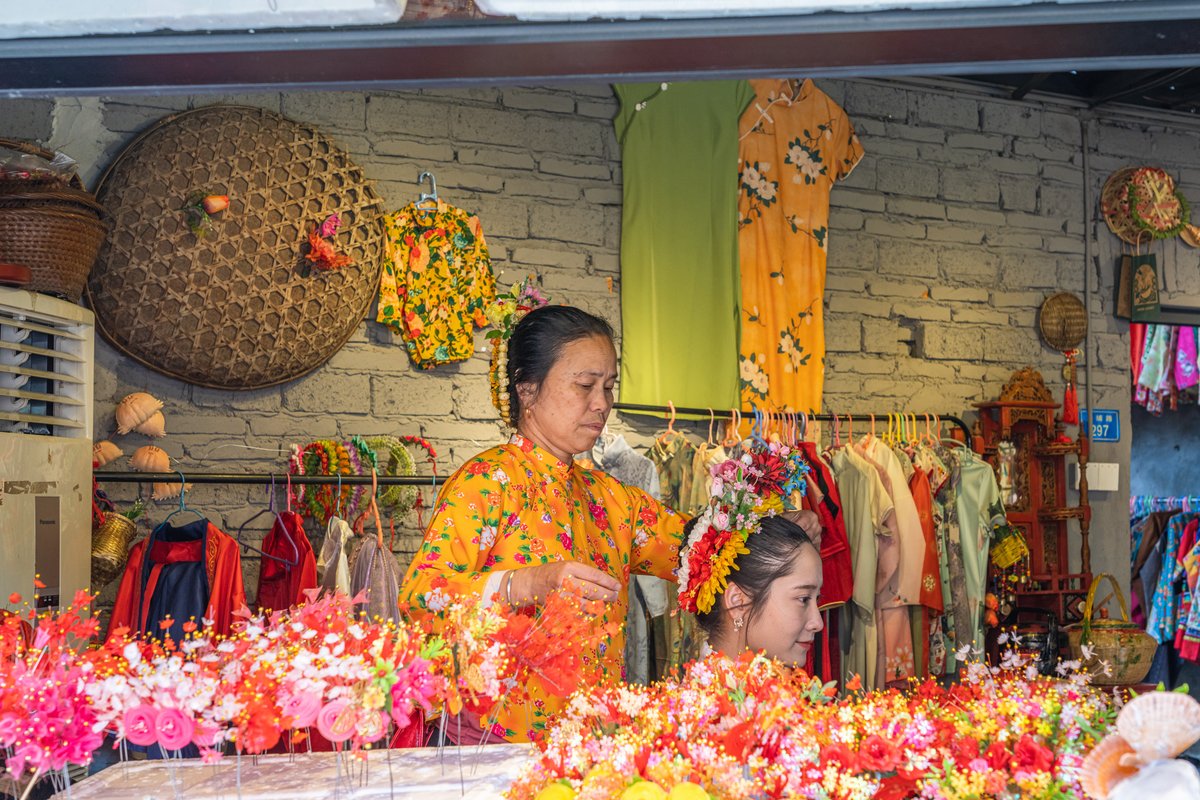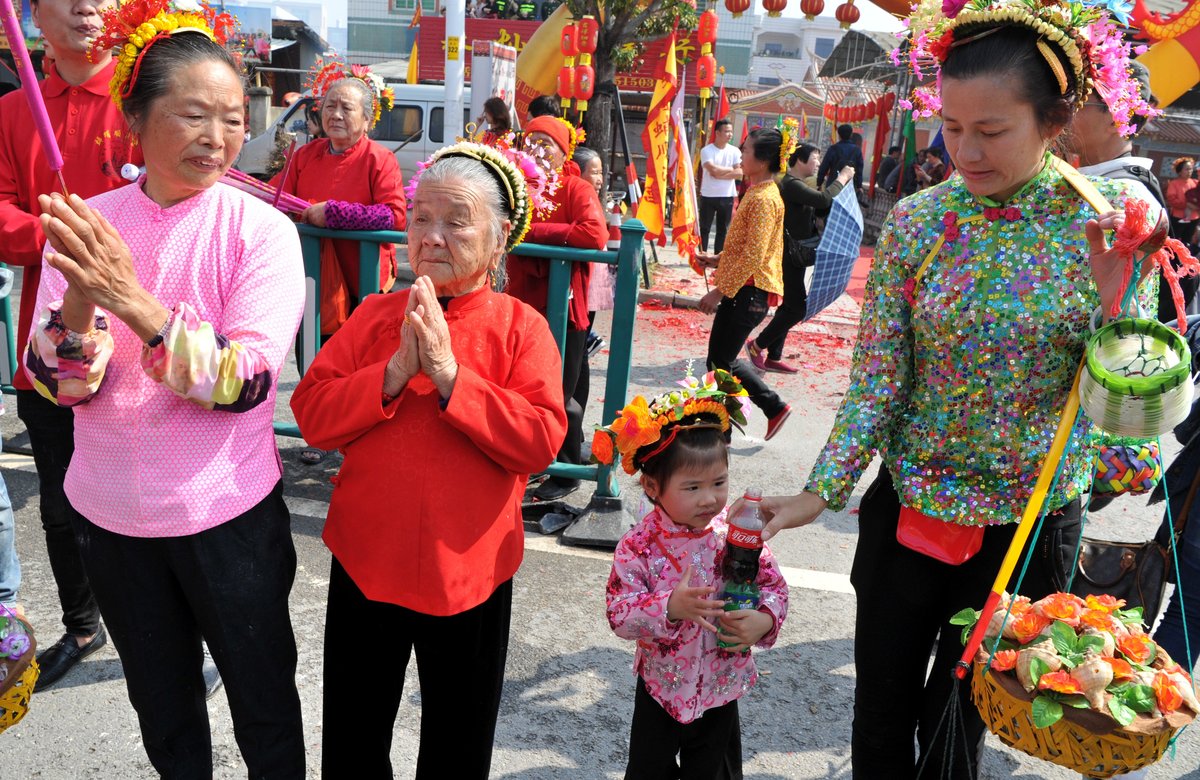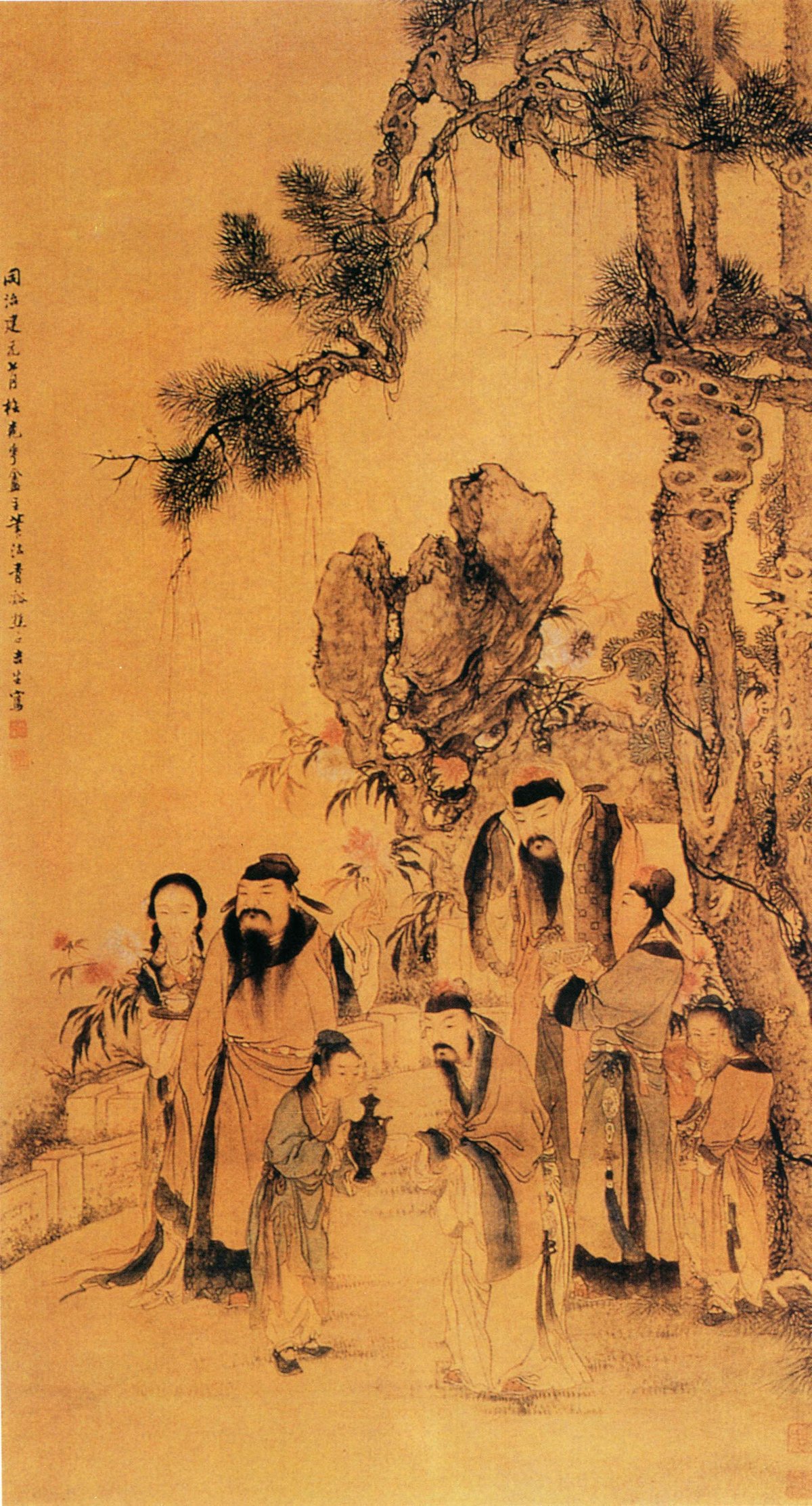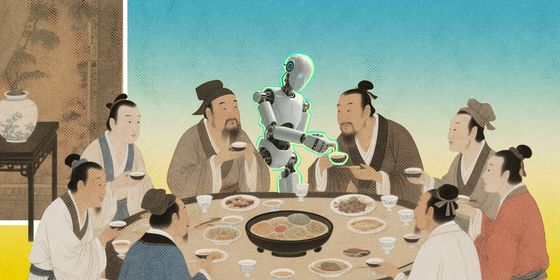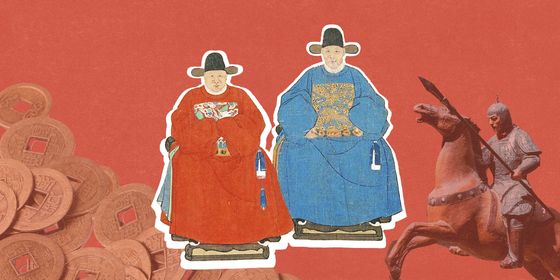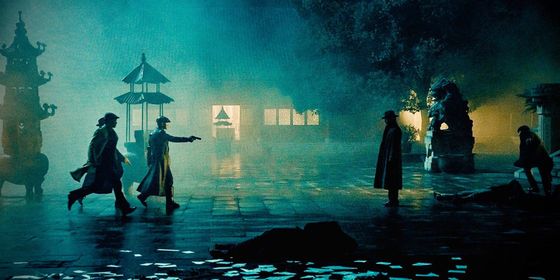From the women of Xunpu to ancient emperors, the floral hairpin has been a cherished tradition among both men and women for centuries, serving as decorative ornaments and symbols of authority
Throughout China’s National Day holiday this year, approximately 50,000 tourists gathered daily in the quaint fishing village of Xunpu, situated ten kilometers from the city of Quanzhou in Fujian. They adorned themselves in a diverse array of costumes, ranging from horse-face skirts to sarong kebaya and Dai ethnic clothing, yet all of them sported a hair wreath adorned with vibrant flowers.
Xunpu gained widespread attention online in January when several celebrities, including the renowned Chinese actress Zhao Liying, shared photos of themselves wearing local headdresses, known as zanhua (簪花) or zanhuawei (簪花围). With their hair tied into a bun, the celebrities wore a wreath embellished with seasonal fresh, plastic, and silk flowers, such as tulips and carnations. Captivated by these stunning images, visitors flocked to Xunpu, leading to the rapid expansion of zanhua boutiques from less than 10 to over 150 in less than six months.
The tradition of wearing flowers has been a part of Xunpu women’s lives since the Tang (618 – 907) and Yuan (1206 – 1368) dynasties when it was first introduced by Arabians. The locals believe that if you “put flowers in your hair in this life, and you’ll also be pretty in the afterlife (今生簪花,来世漂亮).”
Earning a reputation for their hard work, resilience, and compassion, the women of Xunpu are renowned for harvesting the highest quality seafood. They deliberately adorned themselves with floral hairpieces to distinguish their offerings at the local market from those of vendors in neighboring villages. Customers hoping to find the best seafood would then know who to look for.
During joyous events like wedding ceremonies, Xunpu locals traditionally send out invitation cards accompanied by beautiful flowers (the quantity depends on their relationship). In turn, the guests graciously wear the flowers they receive to the celebratory event.
The intricacy of the headdress design also varies by the wearer’s age. Children aged eight to twelve adorn flowers on both sides of their temples, with three strands of braids woven and bangs left on the forehead. Teenagers, around the age of 13, decorate their round bun-like hair with fresh flowers held in place by hairpins. Middle-aged women typically style their hair in a spiral bun, embellished with both flowers and gold hair accessories. When it comes to elderly women, a red headscarf, alongside red flowers and head ornaments, is preferred. The tradition of flower-wearing among Xunpu women has been recognized as part of China’s intangible cultural heritage since 2008.
Even though the tradition in Xunpu is believed to be an imported custom, the flower decoration culture has deep roots in China. The earliest record can be found in the Record on Travel to Nanyue (《南越行纪》) by politician Lu Jia (陆贾) from the Han dynasty (206 BCE – 220 CE), which mentioned women in the state of Nanyue used to adorn themselves with threaded jasmine.
In addition to its accessory purpose, floral decoration carries a deeper meaning of blessing. During the Han dynasty, people, including men, wore cornels as a means to ward off evil spirits and seek longevity during the Double Ninth Festival, a traditional Chinese festival that celebrates the elderly.
Flowers were also a symbol of honor and fame during the sixth century. At an imperial garden banquet in Chang’an (present-day Xi’an in Shaanxi province), Emperor Xuan of Tang asked all ministers to compose poems inspired by scenic surroundings. Among them, the grand secretary Su Ting (苏颋) crafted the line “Flying dust forms crimson mist, the canopy drifts amidst the blue clouds (飞埃结红雾,游盖飘青云).” Impressed by Su’s poetic prowess, the emperor personally inserted a flower from his head into Su’s headdress. This gesture, recounted in Anecdotes of the Tang Under Emperor Xuanzong’s Reign (《开元天宝遗事》), a book completed during the Five Dynasties period (907 – 960), became the envy of many at the time. Subsequently, a zanhua ceremony emerged in the Tang dynasty. Individuals who achieved the rank of jinshi, the highest level in the imperial exam system, were honored with apricot flowers at banquets, as documented in the Annual Customs and Festivals in Qinzhong (《秦中岁时记》) by Tang scholar Li Chuo (李淖).
Competitions exclusively for women in designing flower hairpins also became popular in the Tang dynasty. Participants eagerly invested fortunes in purchasing rare and exotic flowers to increase their chances of winning. From rural courts to ordinary people, the demand for various precious flowers constantly grew, giving rise to a group of skilled florists who delved into cultivating renowned flowers. These florists often stored out-of-season flowers like peonies in underground cellars surrounded by fires, allowing peonies to bloom even in the depth of winter, as noted by Tang novelist Duan Chengshi (段成式) in his work Miscellaneous Morsels from Youyang (《酉阳杂俎》). This growing fascination with flowers also led to the widespread popularity of zanhua among common people as noted in Records on Peony in Luoyang (《洛阳牡丹记》) by historian Ouyang Xiu (欧阳修) from the Song dynasty (960 – 1279). “People, poor or rich, even stick men, all adorned their head with flowers during the spring (春时城中无贵贱皆插花,虽负担者亦然),” he wrote.
In the Northern Song dynasty (960 – 1127), prefecture chief Han Qi (韩绮) in Yangzhou stumbled upon the exquisite blossom of the gold loincloth (金缠腰), a type of peony believed to signify the rise of a prime minister when it bloomed. Impressed by the auspicious discovery in his garden, Han invited Wang Gui (王珪), Wang Anshi (王安石), and Chen Sheng (陈升) from the high court of justice for a sightseeing excursion. Afterward, Han presented each of them with a peony to wear. Thirty years later, all four of them had risen to the position of prime minister. Since then, wearing floral hairpins has become a symbol of a promising official career.
In the late tenth century, flower-wearing became a royal etiquette as “everyone needs to dress impeccably and would receive flowers (from the emperor) during big occasions like the emperor’s birthday celebration, court banquets, and banquets after rituals,” as documented in the History of Song (《宋史》). However, not everyone appreciated the imperial rule. In his twenties, the historian Sima Guang (司马光) despised the tradition, feeling it was extravagant and effeminate. Nonetheless, he had to accept flowers from Emperor Renzong of Song, as officials who refused flowers from the emperor could face impeachment, given that the flower symbolized the authority of imperial power.
Flowers were bestowed upon officials based on their rankings during the Song dynasty, which served as a visual representation of the emperor’s authority. For example, military officials and those of lower ranks received silk flowers, while satin flowers were awarded to officials and ministers at all levels. When the emperor presented peony flowers to officials, it symbolized his recognition and respect for their contributions. Moreover, when the emperor personally adorned newly appointed scholars with flower pins, it represented affirmation and appreciation of their talents. Wearing flowers became an important ceremonial practice for men during grand celebrations and banquets. During the reign of Zhenzong of Song in the tenth century, all officials were required to kneel in court to express their gratitude for the flowers they received.
Poets of that era also used different flowers to convey their emotions. In 1098, poet Huang Tingjian (黄庭坚) tilted his hat adorned with chrysanthemums to “express his indifference to the outside world (付于世人冷眼看)” after the 54-year-old was sabotaged by his political enemies and subsequently dismissed to Rongzhou (present-day Meishan in Sichuan province).
However, the custom of men wearing flowers did not endure. In the late Ming dynasty (1368 – 1644), men wearing flowers became a subject of mockery. According to The History of Ming (《明史》), General Su Jing (苏京), who fell into the hands of the peasant rebel leader Li Zicheng (李自成), ultimately responsible for the overthrow of the Ming dynasty in 1644, was compelled to don female attire and floral hair decorations solely for ridicule. Fast forward to the Qing dynasty (1616 – 1911), floral accessories became reserved only for women, as scholar Zhao Yi (赵翼) stated in Notes on Academic Study (《陔馀丛考》).
While it remains uncertain if the ancient hairpin culture directly influenced the flower-wearing traditions of Xunpu women, the enduring customs have persisted to the present day, symbolizing Xunpu women’s aspirations for a better life.







